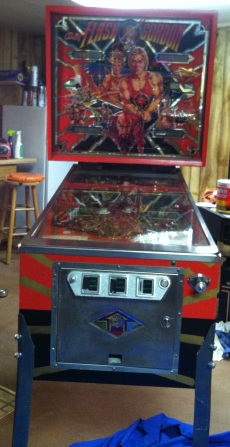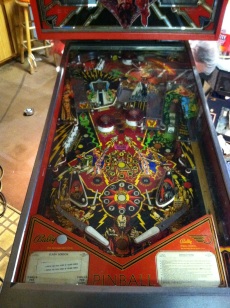Machine Statistics
Production Date: February 1981
Production Run: 10,000 units
Design: Claude Fernandez
Artwork: Kevin O'Connor
The Game Synopsis/History
Flash Gordon, featuring great artwork by Kevin O'Connor, was Bally's first multi-level game and was released just one month after Williams' Black Knight. Based on the movie and comic strip character of the same name, it has a great theme tie-in for a pin from that era. The speech features three voices, including that of Emperor Ming, and is one of the better implementations from this time period. Some unique features for the game are two bonus systems (one for each level), a game clock for double, triple, and 5X playfield scoring, and a bi-directional kick-out saucer that can release the ball to either the upper or lower playfield.
Some have suggested that designer Claude Fernandez copied much of his design from Steve Ritchie's Black Knight. Fernandez left Williams and went to Bally after the the Black Knight design had been finished. Flash Gordon came out only a month after Black Knight so many think he just tweaked Black Knight's design. Personally, I think that he had to have been influenced by Ritchie's design, but that his has enough differences that I wouldn't accuse him of stealing from Ritchie. Either way, it is actually one of the best pins from this era. Many think that if it had included multi-ball, it may have been one of the best pins ever.
Personally, I really like this pin. The sound package was really good and the speech was great for its time. Emporer Ming's voice and laugh is a classic and some of the quotes are perfect such as "Lucky Shot Earthling" when you set up the saucer for 2X bonus or "Try Again Earthling" after you lose a game. The game has the deepest ruleset of any game of that time. The "guard" target is a cool feature as is the bi-directional saucer. The strobe light in the backbox is also a cool feature. This game is also a drain monster (at least mine is). I keep coming back because it is fun and challenging. You have to play well to have a good ball.
One final thought, of all the restorations I have done, this was my favorite. This may be because of how horrible this game looked before versus how great it looked afterward. I liked this pin and restoration so much, that I still have it in my collection. I couldn't part with it.
SECTION 1: Electronics
Problem #1: The displays were intermittent This was a simple problem. The connector and pins on the solenoid/power board needed cleaning. I sanded off the gook and the displays worked fine.
Problem #2: The sound was garbled. Only one speech phrase was intelligible. Some, but not all sounds worked. This was the result of having an extra chip on the Bally Squawk and Talk board. Flash Gordon is supposed to only have chips at U2 and U5. Mine had one on U4 also which was interfering with the signals. Why this chip was even there is a mystery to me. Once I found out the correct chips and their placement, the board worked.
Problem #3: The single "guard" drop target that blocks the entry back to the ball shooter lane would not always drop down at the beginning of a ball. Thus, it was in the way when you plunged a ball onto the playfield. This was a trickier problem to fix than it should have been. The solenoid tested good in the self-test, but during gameplay it worked sometimes and sometimes it didn't. I first checked the wiring to see if a wire was loose. Second, I tested the driver transistor and it tested good. Finally, during the self-test, it did not work even though it had always worked previously. Thus, I knew that the problem had to be something that would cause intermittent operation. After checking the solenoid board, I found that the pin for that particular trace had a cracked solder joint. So, it was just a matter of reworking the pin to get the solenoid to work.
Problem #4: Two playfield lights would not work. This was caused by bad transistors on the lamp driver and the auxiliary lamp driver. Murphy's Law demands that if two lights are out and you have a machine that uses both the lamp driver board and the auxiliary board, they both cannot be on the same board. I replaced the transistors and the lights worked fine. On the auxiliary board I also had to fix a burned trace. I jumped a wire across the path the trace traveled.


